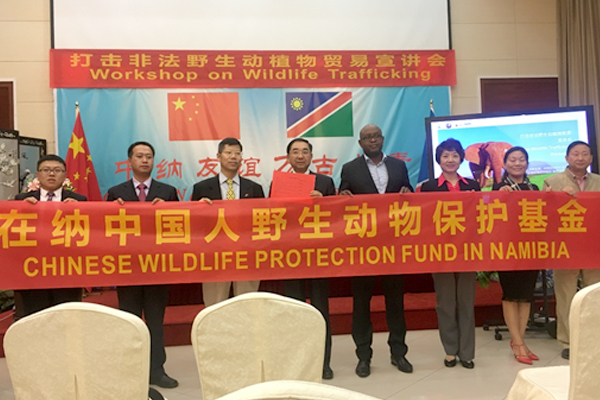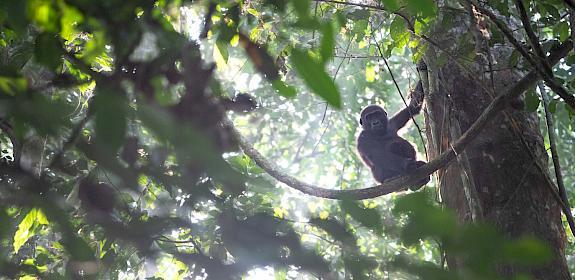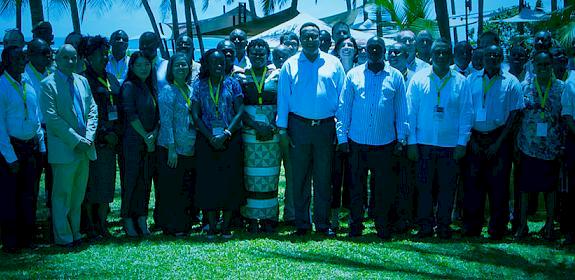China joins Namibia and Zimbabwe in efforts to curb illegal wildlife trade
Windhoek, Namibia, and Harare, Zimbabwe, 12th June 2017—Ministerial level workshops raising awareness against wildlife trafficking amongst Chinese nationals living and working in Namibia and Zimbabwe were jointly hosted by China’s State Forest Administration, China’s CITES[1] Management Authority, TRAFFIC and WWF last weekend, supported by the respective Chinese Embassies.
More than 160 local Chinese nationals from State-owned enterprises, private businesses and residential communities attended the workshops held in Windhoek and Harare respectively. Local NGOs and both local and international media were also present. Tommy Nambahu, Namibia’s Vice Minister of Environment and Tourism and Mandoga, Zimbabwe’s Director of Environment and Natural Resources Department, Ministry of Environment, Water and Climate made the opening remarks at the respective workshops.
Zimbabwe is a popular destination for Chinese tourists to Africa thanks to its abundant wildlife resources. There has been a steady growth in economic and technological co-operation and investment between the two countries in recent years, with China supporting the construction of various infrastructure and factories in Zimbabwe. Namibia is also a popular tourism destination and likewise also maintains extensive economic and cultural exchanges with China following the establishment of diplomatic relations.
However, the increasingly closer ties between China and the two African nations have also created opportunities for illegal exploitation of wildlife species, with products smuggled to meet demand in the Chinese marketplace. The two workshops provided an opportunity for Chinese citizens based in Namibia and Zimbabwe to be made fully aware of the illegality of such activities and the risks of becoming engaged in them.
Representatives from China’s CITES Management Authority spoke about China’s amendments to laws and regulations under the CITES framework, the Convention’s implementation in China, and the implications of China’s impending domestic ivory trade ban.

Zhang Yongli, Vice Minister of China’s State Forest Administration said “The Chinese government attaches great importance to protecting wildlife species and rigorously combatting wildlife crime and has made positive efforts to eliminate endangered wildlife trafficking through establishing a national inter-agency co-ordination mechanism for CITES implementation and enforcement, strengthening Customs’ inspection and market surveillance, and especially through co-hosting consecutive advocacy workshops in African countries to raise Chinese nationals’ awareness of wildlife conservation. ”
The Chinese Ambassador to Zimbabwe, Huang Ping said: “From the strategic height of China’s overall national development, the Chinese government has been consistently improving the legal framework and the laws that provide legal protection to strengthening wildlife protection and combatting illegal trade in wildlife. China will, as always, fulfill in good faith our obligations under international conventions and take active part in international co-operation on wildlife conservation.”
Li Nan, Chargé d’affaires, Embassy of China in Namibia said: “The Chinese government values endangered wildlife conservation. China and Namibia realize the need for mutual support and collaboration on CITES implementation and enforcement and have achieved good progress in attacking wildlife crime.”
“We travelled thousands of miles to Africa to deliver this simple but clear message to Chinese people in African countries: do not purchase ivory or other illegal wildlife products,” said Zhou Fei, Head of TRAFFIC’s China office. “We expect representatives attending these workshops to help relay that message to their respective companies and Chinese communities.”
Tom Milliken, an expert on elephant ivory and rhino horn trade with TRAFFIC spoke about recent trends in the global illegal wildlife trade, in particular trafficking between southern African countries and China. He also spoke about the scale of ongoing African Elephant and rhino poaching triggered by illegal trade in their products.
TRAFFIC staff also provided tips to Chinese nationals on reducing the risk of wildlife trafficking during their international travel and encouraged Chinese enterprises to adopt socially and environmentally responsible policies for conserving local wildlife—for example through buying sustainable souvenirs.
Wang Lei, Forest Programme Manager of WWF China, emphasized how Chinese corporate leaders should adopt best practices in sustainable forest management to help eliminate illegal timber trade between China and Africa.
During the workshops, local Chinese company representatives pledged to continue raising their staff’s awareness about protecting wildlife. A special wildlife conservation fund among Chinese companies and communities operating locally in Namibia was established and raised an initial fund of NAD110,000 (USD8,500).
During the visits, constructive bilateral consultations also took place between China’s State Forestry Administration and their counterparts in Namibia and Zimbabwe respectively. Both sides recognized their shared responsibility in ensuring compliance with CITES regulations and agreed to strengthen information exchange and build enforcement capacity to prevent the smuggling of wildlife products.
This was the seventh outreach workshop of its kind jointly conducted by TRAFFIC and WWF in collaboration with the Chinese government. The first took place in Kenya in January 2014.
Notes:
[1] CITES is the Convention on International Trade in Endangered Species of Wild Fauna and Flora.




